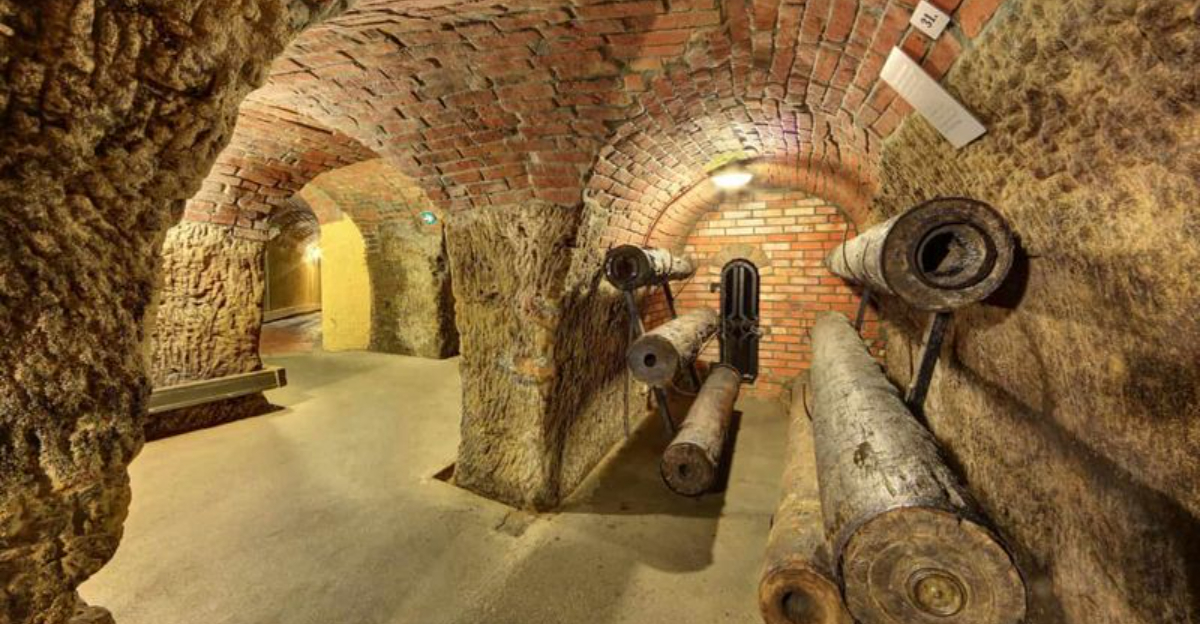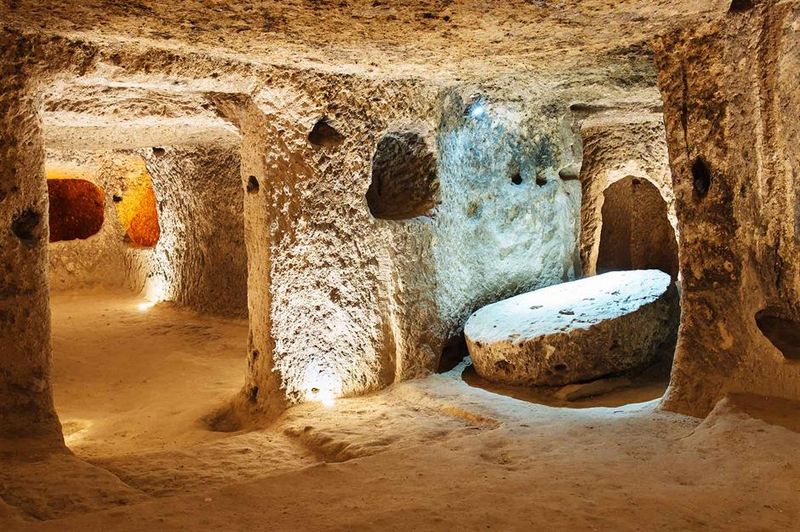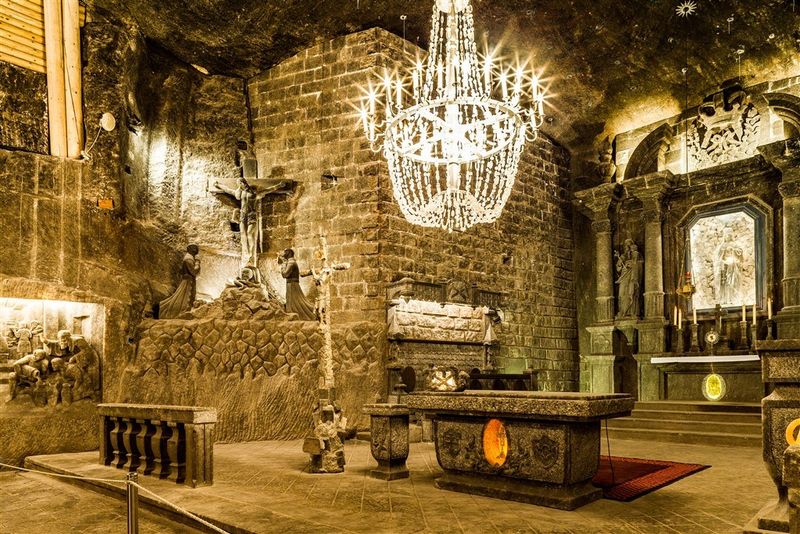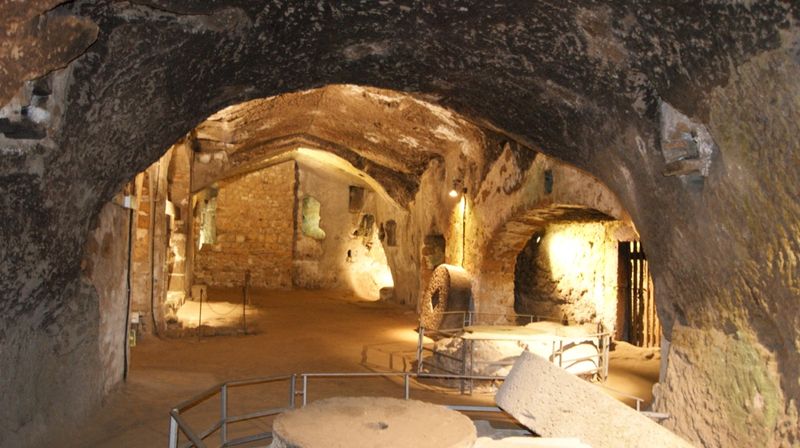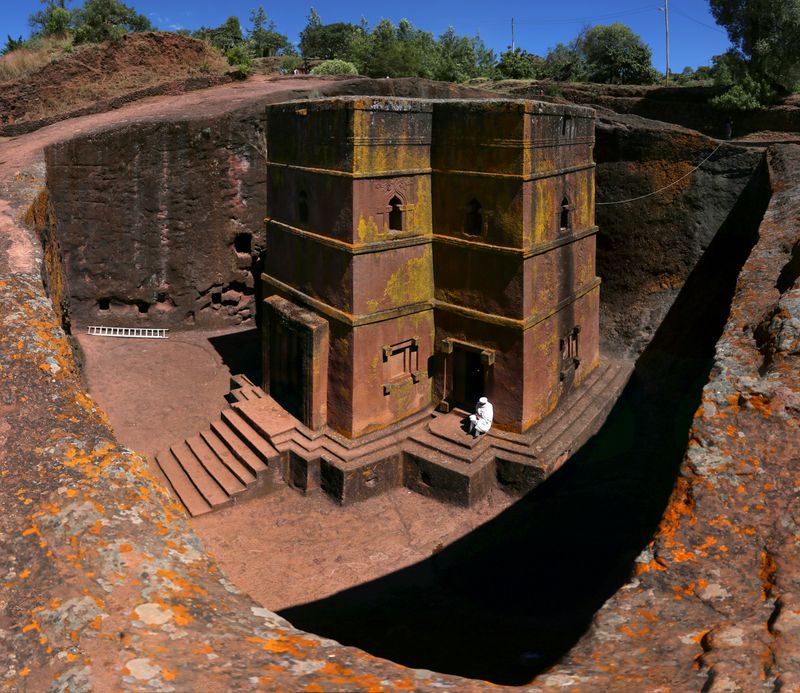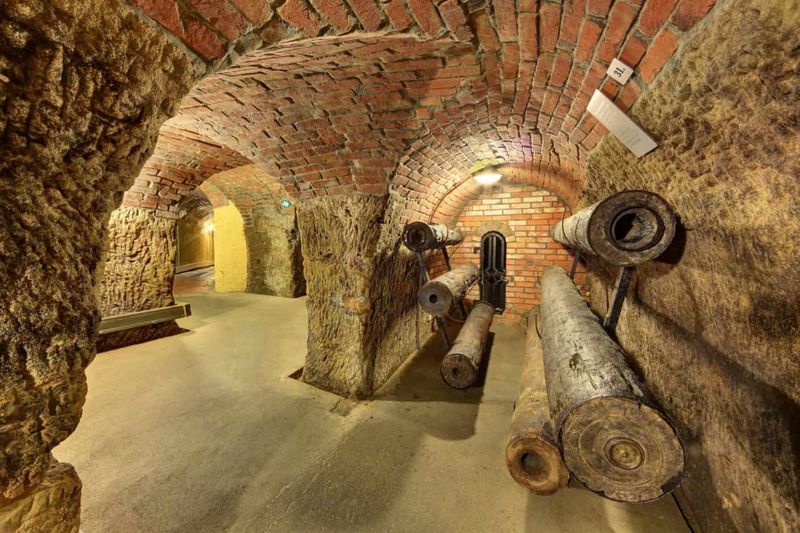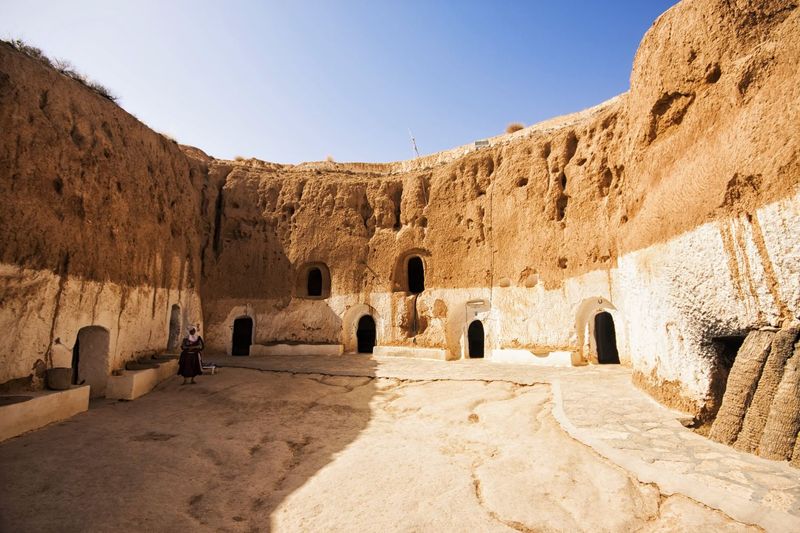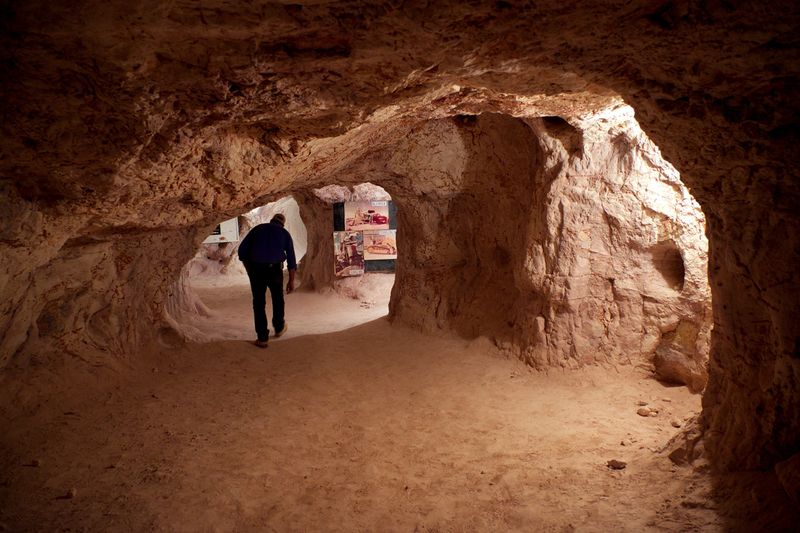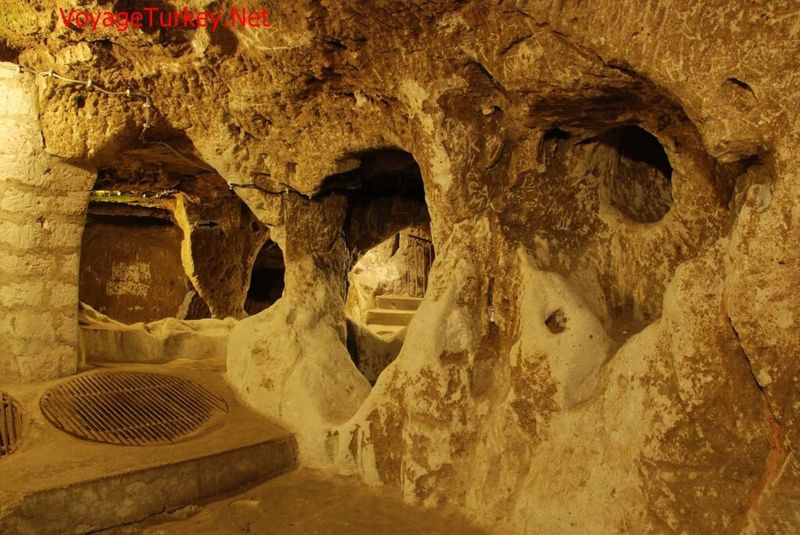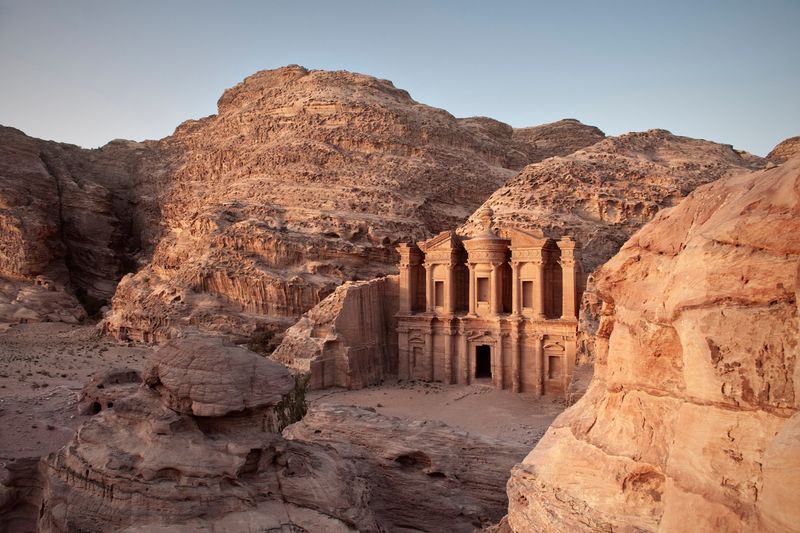Beneath our feet lies a hidden world of underground cities carved by ancient civilizations. These subterranean marvels served as refuges from extreme weather, invading armies, and even nuclear threats. From elaborate multi-level complexes to simple cave dwellings, these underground settlements reveal humanity’s remarkable ingenuity and determination to survive against all odds.
1. Derinkuyu, Turkey (8th Century BCE–?)
Hidden for centuries until a homeowner accidentally broke through a wall in 1963, Derinkuyu remains an engineering marvel that defies explanation. This massive underground complex could shelter 20,000 people across 18 levels, complete with churches, schools, and livestock pens.
Stone doors weighing up to 1,000 pounds could seal off sections during attacks, while clever ventilation shafts maintained air quality 280 feet below ground. Residents could survive for months without surfacing.
Archaeological evidence suggests the Phrygians created this labyrinth, though some theorize it dates back to Hittite times—nearly 4,000 years ago.
2. Kaymaklı, Turkey (8th Century BCE–Byzantine Era)
Narrower and more compact than its neighbor Derinkuyu, Kaymaklı stretches across eight underground levels, though only four are accessible today. Ancient engineers designed this subterranean fortress with low, narrow passages forcing invaders to crouch—making them vulnerable to defenders.
Massive circular stones could be rolled into place, sealing off entire sections within seconds. The city’s name, meaning “with cream,” comes from the distinctive creamy limestone surrounding the region.
Archaeological finds suggest Kaymaklı once housed thousands of Christians fleeing Roman persecution, with evidence of communal kitchens and worship spaces throughout.
3. Naours, France (3rd Century CE–17th Century)
What began as humble limestone quarries transformed into a lifesaving refuge during Viking raids and the Thirty Years’ War. French villagers would disappear underground with livestock and possessions whenever danger threatened above.
Rediscovered in 1887 by a local priest, Naours gained unexpected fame during World War I when Allied soldiers left behind thousands of signatures and graffiti while sheltering here. Some carvings tell poignant stories of homesickness and fear.
The underground network features three main streets with 28 galleries and 300 rooms—including a chapel where clandestine religious services were held during times of persecution.
4. Wieliczka Salt Mine, Poland (13th Century–Present)
Generations of miners transformed this working salt mine into an underground cathedral of art. The most breathtaking feature remains the Chapel of St. Kinga, where everything—altars, statues, chandeliers—is carved from salt rock that gleams like marble.
Mining families developed their own subterranean culture, complete with legends of the “Salt Princess” who supposedly brought wealth to Poland. The mine’s perfect humidity preserves wooden structures for centuries without decay.
Modern visitors can experience the mine’s therapeutic microclimate in its underground health resort, where salt-infused air treats respiratory conditions. Even the floors you walk on can be licked to taste their saltiness!
5. Orvieto, Italy (Etruscan Era, 6th Century BCE–Renaissance)
Perched atop a volcanic plateau, Orvieto hides a secret beneath its medieval streets—a labyrinth of 1,200 underground caves excavated from soft tufa stone. The ancient Etruscans began this underground network, creating wells that reached groundwater 150 feet below.
Renaissance nobles expanded these spaces, adding escape tunnels and private cellars. Some wealthy families owned underground olive presses and pigeon breeding chambers—the birds provided both food and messenger services.
The most ingenious feature remains the Pozzo di San Patrizio (St. Patrick’s Well), a double-helix design with separate staircases for descending and ascending, allowing donkeys to transport water without crossing paths.
6. Lalibela, Ethiopia (12th–13th Century CE)
King Lalibela’s vision transformed a mountainside into 11 monolithic churches—not built up from blocks but carved downward into solid rock. Workers began at the roof and hollowed out entire churches, creating structures united with the living stone beneath them.
Legend claims angels helped complete this massive project in just 24 years. The most spectacular church, Saint George’s, forms a perfect cross when viewed from above, descending 40 feet into reddish volcanic rock.
Narrow tunnels connect the churches, designed for spiritual journeys representing the path to Jerusalem. Orthodox Christian worshippers still pray in these ancient spaces, their chants echoing through chambers carved nearly 900 years ago.
7. Beijing’s Underground City, China (1969–1970s)
Chairman Mao mobilized ordinary citizens to dig this massive bunker network with simple tools and wheelbarrows during rising tensions with the Soviet Union. School children participated in the digging after classes, creating a 62-mile labyrinth designed to shelter Beijing’s entire population.
The complex included everything needed for long-term survival: hospitals, schools, factories, theaters, and even a skating rink. Special ventilation systems could filter radioactive particles, while underground wells provided clean water.
Most fascinating were the secret entrances hidden inside ordinary buildings—a clothing store’s fitting room might conceal a stairway leading to this subterranean world. Today, small sections remain open as quirky tourist attractions.
8. Pilsen Historical Underground, Czech Republic (14th Century–19th Century)
Beer created this underground marvel! Medieval brewers dug cellars beneath Pilsen to maintain perfect temperatures for fermenting their world-famous lagers. As centuries passed, these cellars expanded into interconnected networks spanning 12 miles.
During the Thirty Years’ War, these passages became lifesaving escape routes. Residents could vanish from one house and emerge blocks away, confounding enemy soldiers. The tunnels’ tight turns were intentionally designed to prevent invaders from using pikes and long weapons effectively.
Archaeologists continue discovering artifacts in these passages, including a complete medieval brewery with original wooden equipment preserved by the cool, stable environment that once made Pilsen beer so exceptional.
9. Edinburgh Vaults, Scotland (18th Century–19th Century)
Beneath Edinburgh’s South Bridge lie chambers with a dark history. Originally built as storage spaces for merchants, these vaults quickly deteriorated when poor ventilation and water seepage made them unsuitable for goods.
The city’s poorest families moved in despite horrific conditions—no sunlight, running water, or sanitation. Criminals soon followed, establishing illegal pubs, gambling dens, and brothels. Body snatchers Burke and Hare allegedly hunted victims here to sell to medical schools.
Abandoned by the 1830s, these vaults were rediscovered in the 1980s during renovation work. Ghost hunters now consider them among Britain’s most haunted locations, with visitors reporting cold spots, mysterious touches, and disembodied voices.
10. Matmâta, Tunisia (Ancient Berber Era–Present)
Star Wars fans recognize these underground homes as Luke Skywalker’s childhood residence on Tatooine. The reality behind these dwellings proves equally fascinating—Berber tribes excavated massive pits 30 feet deep into sandstone, then carved rooms into the walls.
This ingenious design maintains a steady 68°F temperature year-round despite brutal desert conditions. Central courtyards capture rainwater while providing natural light to surrounding chambers.
When French colonizers arrived in the 1900s, they were shocked to discover entire communities living “invisibly” beneath the desert surface. Some families still maintain these traditional homes today, though many have been converted to hotels where tourists can experience underground living.
11. Coober Pedy, Australia (1915–Present)
When opal miners discovered that burrowing underground was the only escape from the scorching Outback heat, a remarkable subterranean town was born. Temperatures above ground regularly exceed 120°F, while underground homes maintain a comfortable 75°F without air conditioning.
Residents have created everything underground—churches with beautiful carved altars, bookstores, bars, and even a four-star hotel. Mining equipment carves out new rooms whenever families need to expand.
The town’s name comes from the Aboriginal words “kupa piti” meaning “white man’s hole.” Nearly 70% of the world’s opal comes from this unusual community where finding precious gems while renovating your living room isn’t uncommon!
12. Özkonak, Turkey (Byzantine Era, ~4th Century CE)
While smaller than its famous neighbors, Özkonak boasts unique defensive features that reveal the ingenuity of its Byzantine creators. Narrow ventilation shafts doubled as communication tubes—residents could speak through them while staying safely hidden during raids.
Most chilling are the murder holes positioned above doorways. Defenders would pour hot oil on invaders through these openings, creating deadly choke points throughout the complex.
Unlike other underground cities, Özkonak features stone doors that slide sideways rather than roll, operated by clever counterweight systems. A local farmer discovered this underground marvel in 1972 after noticing water mysteriously disappearing into the ground during irrigation.
13. Dixia Cheng, China (1970s)
While ordinary citizens dug Beijing’s main underground city, government officials secretly constructed Dixia Cheng—a separate facility designed for Communist Party leadership. This elite bunker included luxury accommodations and advanced communication systems unavailable in the public shelters.
Engineers designed the complex to withstand direct nuclear strikes, with multiple redundant systems for power, water, and air filtration. Secret underground railways connected government buildings to this facility, allowing rapid evacuation.
Only recently opened to limited tourism, visitors report seeing Mao-era propaganda still adorning walls alongside maps showing planned missile strikes against Western targets. Much of the complex remains restricted, fueling speculation about what might still be hidden beneath Beijing.
14. Hypogeum of Ħal-Saflieni, Malta (3300–3000 BCE)
Carved using only stone tools and antler picks, this Neolithic wonder descends through three levels of limestone—each more mysterious than the last. The uppermost level contains burial chambers, while the middle level houses the extraordinary “Oracle Chamber.”
Words spoken in this room create resonating echoes that vibrate at a frequency of 110 Hz—precisely matching theta waves in the human brain associated with trance states. Archaeologists believe priests used these acoustic properties during rituals.
The deepest level, called the “Holy of Holies,” contains a small carved pit that once held sacred snakes. Archaeologists discovered over 7,000 human remains here, many showing evidence of an unusual elongated skull shape that continues to puzzle experts.
15. Petra, Jordan (4th Century BCE–7th Century CE)
Beyond Petra’s famous rose-colored façades lies an extraordinary underground world rarely seen by tourists. The Nabataeans carved elaborate water cisterns, channels, and dams beneath the city—engineering marvels that collected every precious drop of rainfall in this desert environment.
Secret tunnels connected important temples, allowing priests to appear mysteriously before crowds during ceremonies. Some passages were designed to flood deliberately during specific astronomical alignments, creating dramatic effects for religious rituals.
Most impressive are the underground tombs containing sarcophagi of Nabataean royalty. These chambers feature water-tight seals and were designed to flood periodically as part of burial ceremonies symbolizing rebirth—a sophisticated system still functioning 2,000 years later.
